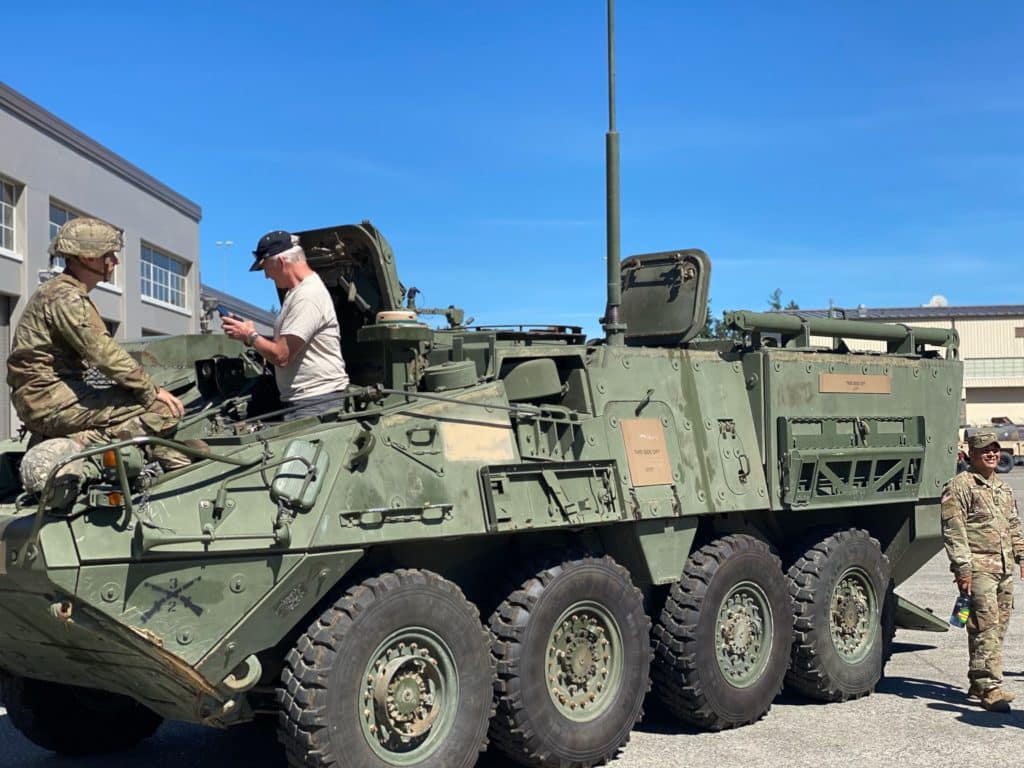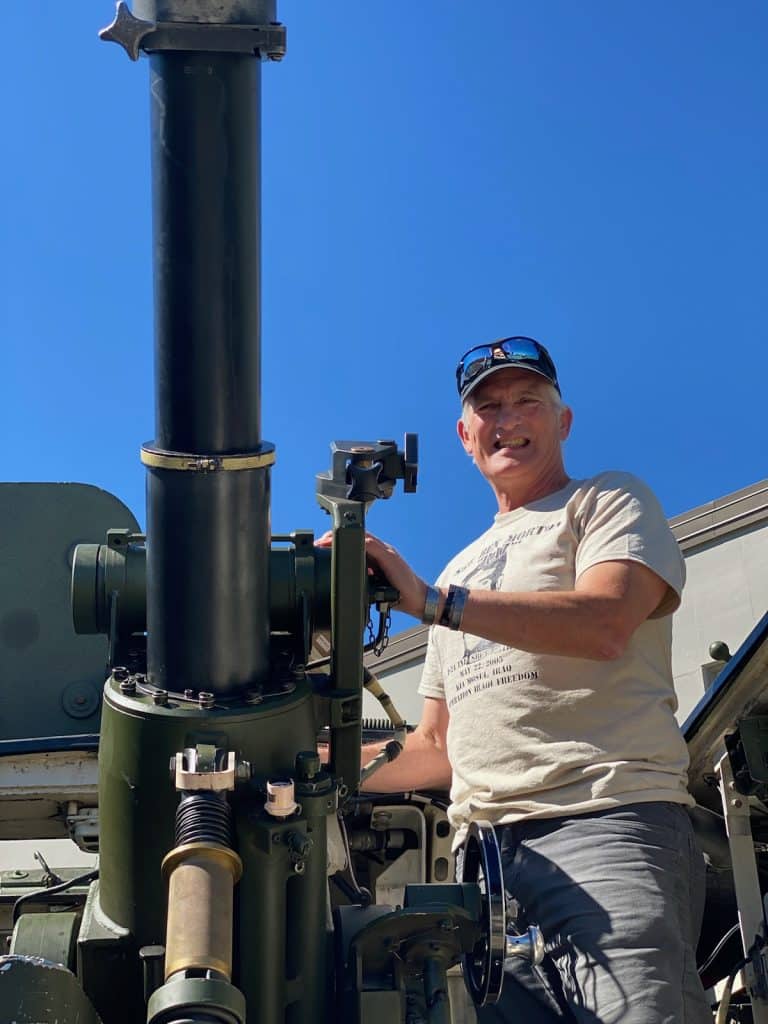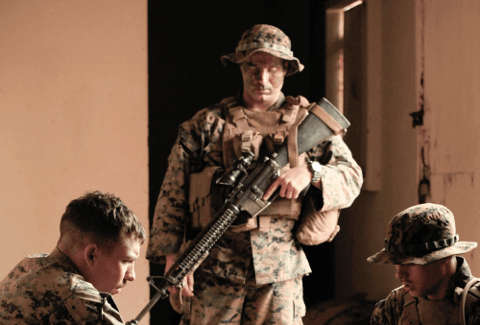On a dark, rainy November day, I was able to witness our modern version of Nidavellir, and watch our own skilled craftsmen assemble one of our nation’s versions of Thor’s hammer. I traveled to Alabama, to the Anniston National Army Depot (ANAD) to see the final assembly of the M-1126 Stryker family of vehicles; a vehicle the lives of men very dear to me depended upon for more than two years of combat deployment.

During the 1990s, a few top military men began to realize that our army wasn’t capable of quickly responding to a crisis that required the immediate deployment of troops in the field in faraway places. We either had very light forces, such as the 82nd Airborne or the 75th Ranger Regiment; or heavy conventional forces such as the 3rd Infantry Division. Our light forces could deploy across the globe at a moment’s notice, but could not hold or remain in a hostile area without rapid reinforcement. Our heavy forces could hold or remain in a hostile area for a long period of time, but had to use ships to bring equipment overseas—a painfully slow process, when forces were required to respond to a crisis immediately. Operations in places such as Panama, Grenada, Haiti, and Somalia showed a lack of rapid deployment capability by conventional forces.
No more poignant highlight of this weakness was our deployment of troops to Bosnia, where a civilian airport in Albania had to be used to fly in troops and supplies. The airport had just a single runway, and civilian operations continued throughout the deployment of American troops, slowing down operations to a snail’s pace. Then the task force conducted an arduous and slow overland journey to Bosnia, on bad roads and bridges that couldn’t hold up under the weight of heavy vehicles like the 70-ton M-1. The whole deployment process was a fiasco, and it pointed to the need for a middle option or interim force. Under the direction of Chief of Staff General Eric Shinseki, and Secretary of the Army Tom White, studies were done that led to the creation of the battalion combat team; a self-contained force that could be deployed anywhere in the world within 96 hours. A fleet of C-17s was built to handle the transport, and the army sought a design for an interim combat vehicle to rapidly get troops into combat; a vehicle that could fit into a C-17’s or C-130’s cargo hold. The army chose a design based on the General Dynamics Land Systems manufactured Canadian Light Armored Vehicle III, and the M-1126 Stryker family of vehicles was first delivered to the army in April 2002.
The Stryker is named after two Medal Of Honor awardees, one from World War II, and one from Vietnam. After extensive testing, including a drive-off versus the Bradley Fighting Vehicle at Fort Knox, the Stryker entered combat service in November 2003 with the 1st Stryker Battalion Combat Team of the 3rd Brigade, 2nd Infantry Division. There are currently eight Stryker Brigade Combat Teams (BCTs), 6 active and 2 reserve, with a total fleet of approximately 2600 vehicles. The brigade at Fort Wainwright has returned their vehicles, and a decision is pending on which unit will receive them to bring the total back to 9 BCTs. In the 20 years and 30 million miles of nearly continuous combat operations to Iraq and Afghanistan, the vehicle, known as “the truck” to its troops, distinguished itself in combat operations. It did especially well in urban operations in Mosul and Baghdad, where it quickly and quietly delivered troops to their destinations.
Of course, the enemy is, in football terms, on scholarship too; and insurgents did their best to attack the Stryker with IEDs (improvised explosive devices) planted in the ground or loaded into civilian vehicles. Even damaged, the Strykers protected their occupants: One vehicle commander told me that his first conscious perception after his vehicle was hit by a massive IED delivered in the trunk of a luxury sedan was the fire suppression system working in the cabin. Another Stryker with the moniker “The General Lee'' after the Dukes of Hazzard TV show, was hit in Iraq by a buried IED so powerful that it lifted the nearly 20-ton truck up 10 to 12 feet up in the air and it landed on its side.
The crew emerged without any serious injuries, and The General Lee was towed back to the forward operating base, returned to the United States, repaired, and returned to combat status. It was the combat equivalent of taking a standing 8 count in a heavyweight boxing match and winning the fight. The General Lee was on station in Europe for several years and enjoyed rock star status as being the only Stryker in the fleet allowed to carry its nickname. The vehicle was loaned to the Polish army for two years and returned, retired in 2019, and now sits in the museum at Fort Belvoir. Some Strykers were used by Special Forces units, and one of the operators made a special point of traveling to personally tell a project manager at General Dynamics that the vehicle saved his life.
As the years progressed, General Dynamics was tasked with making improvements to the Strykers, including bottom protection of the hull with a Double-V Hull design (DVH), applique ceramic armor, and a slat armor “birdcage” to protect the vehicle against RPG’s. Currently, the new A-1 version of the Stryker is being built to replace the original vehicles fielded 20 years ago. It has a bigger power plant, the Caterpillar C-9 450 horsepower engine, a 910 amp electrical system, and a beefier suspension system to better handle the vehicle load, which had previously been burdened by the weight of the slat armor and logistics. In addition, a new air defense system version of the Stryker, the M-SHORAD, is being manufactured for the army as well. This system is critically important as now aerial drones have become a part of the combat environment. The vehicle hulls are built at facilities in Lima, Ohio, and London, Ontario. Full vehicle assembly takes place by General Dynamics Land Systems at the Anniston National Army Depot, where I spent the day talking to the people who build Strykers for a living.

So, who are the craftsmen who are working in Nidavellir to build these tools for our army? My first point of contact was Catherine Doherty, a U.S. Government employee with 41 years of service. She started in the secretarial pool and worked her way up the corporate ranks to become a project manager. Catherine has worked for the Stryker project since its inception 22 years ago and has regularly traveled all over the United States and to the middle east as a part of her job to support the Stryker Brigade troops. In January, she retired. Her distinguished career earned her four letters of commendation from army generals. She was also the only civilian to earn a military decoration for her devotion to the army. She has taken every death in a Stryker as a personal loss, which is personally a totally different perception than the faceless nameless military-industrial complex.
The nameless rectangular assembly building, with just a number for a name, sits in the middle of a sprawling complex of buildings and boneyard lots containing the hulks of retired Strykers as well as some M-1 Abrams tanks as well. The retired vehicles are being stripped by ANAD employees for usable parts, being refurbished to code A condition, and given to General Dynamics for assembly. If the hull condition warrants, the donor hulls are being rebuilt into refurbished machines for foreign assistance programs. Outside the main assembly building sit brand-new Stryker hulls wrapped in protective plastic, waiting to be moved inside to start the final assembly process. From 2004 to 2009, this area of ANAD was a hive of activity, but now in peacetime, it churns along at a much slower pace.
As we entered the facility, it had the atmospheric feel that it could be any workshop, just about anywhere in America. There were regular guys working with regular power tools just like any shop class in a high school or tech school had taught them. One of the tools used by the workers to haul heavy steel crew doors is an over-the-counter carrying clamp bought at Home Depot for $27. A couple of building stories overhead were the leftovers of a former assembly process, a derrick to lift heavy armor bodies up to advance them along the building steps. Now, however, a much better way of moving the heavy steel armor bodies through the building has been developed. It is a large trundle, called the “turkey roaster,” which is a steel frame that allows the Stryker body to be serviced outside and inside. The body can also be flipped upside down so the technicians can work standing on the underside of the vehicle without having to crawl underneath it. When each step in the process is complete, the trundle rolls on small tracks on the concrete floor to bring the vehicle to the next assembly station in the building.
All the systems are added to the vehicle in each succeeding station: Electrical, hydraulics, electronics, vehicle hatches, and rear doors. The Caterpillar engines are mated with the Allison transmissions off-site in an assembly called a FUPP (Fully Uploaded Power Plant), and directly installed and mounted to the drive train. The FUPP is a remarkable piece of American engineering and technology, and the added horsepower should be able to provide our service members with better performance in the field.
The crane arm, made of pivoting metal plates, uncoils and lifts up the crew seat off the floor to the height of the interior cabin. The crane arm is then able to flex 90 degrees and then extend into the cabin to position each seat in the correct position over the cabin floor mounting brackets. With work, the assembly crew improved the flex crane, and it became fully operational in April 2022. Currently, the flex crane is being tested on other loose assemblies for the cabin, including a 250-pound ammo storage box. The amount of man-hours saved by this imaginative invention, as well as wear and tear on the bodies of the assembly crews, is tremendous; a testament to the innovative mindset of the managers at General Dynamics Anniston Operations.
As we exited the building, one of the completed Strykers was fired up to drive out of the facility, and I got to hear the sound of the Caterpillar C-9 power plant come to life. As someone who spent time working around diesel engines in a freight yard, the quiet decibel level of the engine was a real shock. It was like hearing Thor strike his hammer with a muffled thump instead of a loud clang; a fitting end to a day observing the assembly of a mighty machine. I could not help but think that if this vehicle were in service 20 years before, how much of a difference it would have made on the urban streets our troops fought in around the world.
When I visited the General Dynamics assembly facility, it was tasked with completing 1.5 vehicles per day. But due to parts and labor shortages, a common thing in the civilian world, it was having issues meeting that production level. We achieved greatness as a nation because we made things, and the people employed at General Dynamics demonstrate that we can still do it.
The crews of men and women who work in our nation’s own version of Svartalfheim see themselves as ordinary people. They don’t realize how exceptional they are, and how important their work is to the security and welfare of our nation.



